Blog 442
At Gresford, a couple of weeks ago, I was given two samples
from a furnishing fabric book and asked to make a bag from them. Here’s how I
did it.
Furnishing samples
First, I took a 4” strip off the top of the two samples for
the handles.
Handles
For each handle, I made 1” fold along the length of the fabric
and pressed it towards the middle. I pressed a ½” seam allowance along the other
raw edge. I then folded this edge over to lie slightly off centre and to cover the
other raw edge. I secured it with pins and used a matching thread to sew a
central line along the length to complete the handle.
First fold
Second fold
Third fold
Central seam
I placed the remaining large pieces RS together and sewed ½”
seam around 3 sides, leaving one edge open for the top of the bag. Because the
fabric was fraying, I sewed a small zigzag around the edge.
Bag side seams

Zigzagged edges
Around the top edge of the bag, I pressed a 1” double seam (fold
over 1” and fold over the same again). I measured and pinned the centre point.
I then measured 4” on either side of this pin and put in more pins to mark the
spot.
Top edge
Position of handles
I placed the handles RS down onto the top edge of the bag so
that the raw edges were level with the fold. (The edge of the handle was level
with the outer pin.) The first line of stitching around the bag top followed
the line of the fold underneath and trapped the handles in place.
Sewing the top edge
The second line of stitching was along the top edge of the
bag and it secured the handles in their position.
Securing the handles
Secured
With the bag WS outwards, the lower seam was flattened and a
line drawn 3” from the point at each end. Sewing on this line shaped the base
of the bag. The points were then folded towards the seam and sewn in place to
tidy the base.

Shaping the base
Securing the points
And, Ta Dah, you have a bag to replace the plastic ones
dished out at the supermarket!














































